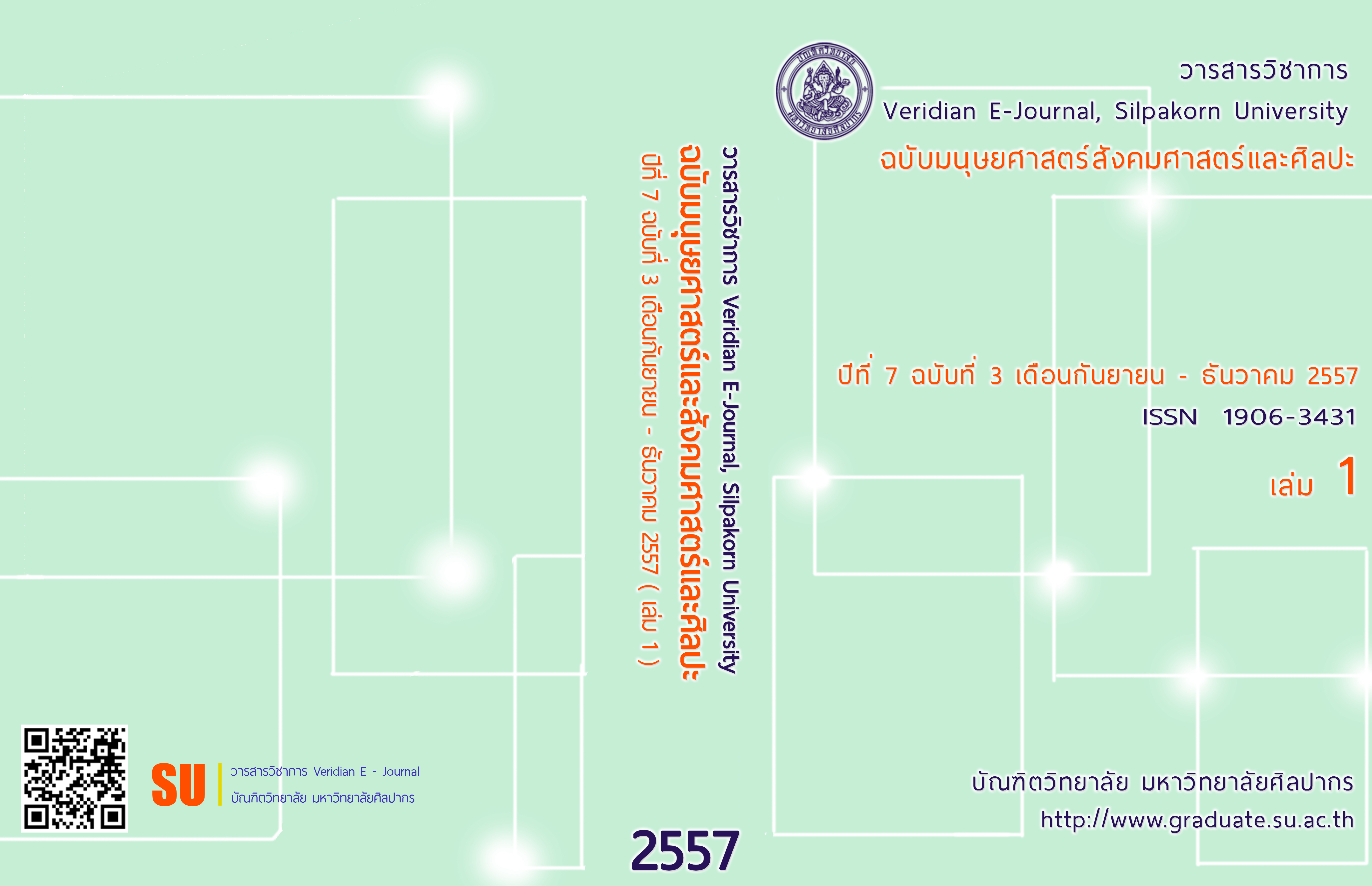การศึกษาหลักฐานทางประวัติศาสตร์การตั้งถิ่นฐานและการพัฒนาเมืองนครปฐม เพื่อการวางแผนอนุรักษ์และพัฒนาชุมชน / A Study on Historical Evidences of Human Settlement, Urbanization, and Development of Nakhon Pathom City for Conservation and Development Planning
Main Article Content
Abstract
บทคัดย่อ
การวิจัยนี้มีวัตถุประสงค์ เพื่อศึกษาทฤษฎี แนวความคิดและหลักฐานการตั้งถิ่นฐานของเมือง การผสานองค์ความรู้ในมิติด้านประวัติศาสตร์เข้ากับกระบวนการวางผังเมือง เพื่อเป็นพื้นฐานในการวางแผนอนุรักษ์และพัฒนาเมืองนครปฐมในอนาคต ระเบียบวิธีวิจัย ใช้วิธีการศึกษาจากเอกสาร หนังสือ ตำราและงานวิจัย ประกอบกับการสำรวจภาคสนาม ใช้เครื่องมือระบุตำแหน่งบนพื้นโลก (GPS) ในการระบุตำแหน่งสถานที่สำคัญทางประวัติศาสตร์ วิธีการวิเคราะห์ใช้วิธีการวิเคราะห์เนื้อหา และการนำข้อมูลสถานที่ทางประวัติศาสตร์กำหนดลงบนแผนที่พื้นฐานแล้วทำการวิเคราะห์โดยการซ้อนทับ (Overlay Analysis) บนผังเมืองรวมเมืองนครปฐม
ผลสรุปจากการวิจัยพบว่าการสร้างเมืองนครปฐมไม่มีหลักฐานแน่ชัด แต่โบราณสถานโบราณวัตถุที่ขุดค้นพบมีข้อสันนิษฐานว่าเป็นส่วนหนึ่งของอาณาจักรทวารวดี ซึ่งรุ่งเรืองในช่วงพุทธศตวรรษที่ 11 - 16 เมื่ออาณาจักรทวารวดีล่มสลาย นครปฐมกลายเป็นเมืองร้าง เนื่องจากแม่น้ำเปลี่ยนทิศทาง นครปฐมกลับมาเป็นเมืองอีกครั้งจากการที่รัชกาลที่ 4 ทรงค้นพบและบูรณะปฏิสังขรณ์องค์พระปฐมเจดีย์หลังจากนั้นมีการขุดคลองเจดีย์บูชาขึ้นเพื่อใช้ในการเสด็จมานมัสการ การตั้งถิ่นฐานในระยะแรก จึงมีลักษณะเป็นแนวยาวตามเส้นทางคมนาคม เมื่อเมืองเติบโตขึ้นจึงกระจุกตัวหนาแน่นบริเวณโดยรอบองค์พระปฐมเจดีย์จนกลายเป็นศูนย์กลางเมือง จากการวิเคราะห์คุณค่าความสำคัญทางประวัติศาสตร์ สามารถจำแนกตามยุคสมัยได้ดังนี้ คือ สมัยทวารวดี ได้แก่ พระประโทณเจดีย์ เจดีย์จุลประโทน วัดธรรมศาลา วัดพระเมรุ และคูเมืองทวารวดี สมัยรัชกาลที่ 4 ได้แก่ องค์พระปฐมเจดีย์ และคลองเจดีย์บูชา สมัยรัชกาลที่ 6 ได้แก่ พระราชวังสนามจันทร์ และสะพานเจริญศรัทธา เมื่อนำสถานที่เหล่านี้มาวิเคราะห์โดยการซ้อนทับลงบนผังเมืองรวมเมืองนครปฐมแล้วพบว่า มีการวางและจัดทำผังเมืองที่เหมาะสมอยู่เพียงแห่งเดียว คือ บริเวณพระราชวังสนามจันทร์ ส่วนอีก 2 แห่ง มีการกำหนดเป็นพื้นที่สีน้ำตาลอ่อนเช่นกัน แต่ไม่ได้คำนึงถึงบริเวณโดยรอบ ได้แก่ วัดพระเมรุ และ คูเมืองทวารวดี นอกจากนั้นอีก 6 แห่งยังไม่เหมาะสมและไม่คำนึงถึงคุณค่าทางประวัติศาสตร์อีกด้วยได้แก่ พระประโทณเจดีย์ เจดีย์จุลประโทน วัดธรรมศาลา องค์พระปฐมเจดีย์ คลองเจดีย์บูชา และสะพานเจริญศรัทธา
แนวทางในการวางแผนอนุรักษ์และพัฒนาเมือง เสนอแนะให้นำกฎหมายที่เกี่ยวข้องมาใช้บังคับร่วมกัน ได้แก่ 1) พระราชบัญญัติโบราณสถาน โบราณวัตถุ ศิลปวัตถุ และพิพิธภัณฑสถานแห่งชาติ พ.ศ.2504 เพื่อดำเนินการขึ้นทะเบียนโบราณสถานและสถานที่ตั้งสำหรับหลักฐานทางประวัติศาสตร์ใดยังไม่ได้ขึ้นทะเบียน 2) พระราชบัญญัติการผังเมือง พ.ศ.2518 ในการวางและจัดทำผังเมืองรวมโดยกำหนด การใช้ประโยชน์ที่ดินประเภทอนุรักษ์เพื่อส่งเสริมเอกลักษณ์และศิลปวัฒนธรรมไทย (สีน้ำตาลอ่อน) และประเภทที่โล่งเพื่อนันทนาการและการรักษาคุณภาพสิ่งแวดล้อม(สีเขียวอ่อน) ในบริเวณสถานที่ตั้งและโบราณสถาน และบริเวณเขตกันชนตามลำดับ ในการวางผังถนน ควรรื้อฟื้นโครงการถนนพุทธบูชาและถนนในแนวแกนเหนือ-ใต้และแนวแกนตะวันออกตะวันตก ให้เป็นถนนกว้างและสง่างามเพื่อเปิดมุมมองจากส่วนต่างๆ ของเมืองให้องค์พระปฐมเจดีย์โดดเด่น 3) พระราชบัญญัติควบคุมอาคาร พ.ศ.2522 ผ่านข้อบัญญัติท้องถิ่นเพื่อควบคุมการปลูกสร้างและดัดแปลงอาคาร ความสูง และระยะถอยร่นในบริเวณสถานที่ตั้งโบราณสถาน และ 4) การจัดทำแผนอนุรักษ์และพัฒนาเมืองนครปฐมที่มีรายละเอียดของการอนุรักษ์สถานที่สำคัญต่างและการพัฒนาบริเวณโดยรอบที่ส่งเสริมและเกื้อกูลบริเวณอนุรักษ์
คำสำคัญ: หลักฐานทางประวัติศาสตร์, เมืองสมัยทวารวดี, เมืองสมัpรัตนโกสินทร์, การวางแผนอนุรักษ์และพัฒนาเมือง, เมืองนครปฐม
Abstract
This research aims to study theories and concepts of human settlement, urbanization and evidences of habitation within an old city, as well as the integration of historical knowledge into a city planning process. Results from the study will be used as a basis for conservation and development planning of NaKhon Pathom in the future. Research methods employed include data and information collection from various secondary sources accompanied by field survey. To identify the significant historical areas, (GPS: Global Positioning System) was used to locate the definite sites on the base maps. Afterwards, the information was classified and analyzed by overlaying the historical areas map on top of the adopted Nakhon Pathom General Plan B.E. 2544. Finally, the composited map indicates numbers of substantive mishandling historical places and sites that should be corrected.
The finding is that there is still no substantive evidence of city establishment. However, archaeological site and finds convince historians to assume that Nakhon Pathom was one of the Kingdom of Dhavaravadi which flourished during 11-16 B.E.. After the ruin of Dhavaravadi, Nakhon Pathom became deserted due to the change of river line. The city became occupied again after King Rama IV had found and restored Prapathom Chedi. The King had initiated an idea to construct the canal, which is now so-called Klong Chedi Bucha, to facilitate his journey to the pagoda. As a result, the linear settlement was formed along the canal. After the century of growth, urbanization is now concentrated around the pagoda which was the centre of the city. A result of the archaeological finds also provides sufficient information to group 9 historical places based on 3 periods. Prapathon Chedi, Chunlaprathon Chedi, Wat Thammasala, Thung Prameru and Moat of Dhavaravadi are grouped in Dhavaravidi Period. Prapathom Chedi and Chedi Bucha Canal are grouped in King Rama IV period. Sanam Chan Palace and Charoen Satha Bridge are in King Rama VI period. The overlay analysis reveals that only Sanam Chan Palace has a suitable city planning while the other 8 places have been planned without the concern of historical places’ significant.
For conservation and development planning of Nakhon Pathom, the 3 related Acts should be utilized and enforced as tools for the plan implementation. 1) As provided by the Historical Place, Monument, Art Object and Museum Act B.E. 2504, unregistered historical places should be registered as national historical landmarks immediately. 2) In preparing the city general plan according to the City Planning Act B.E. 2518, all historical place and sites and the surrounding areas should be assigned as conservation or open space and recreation types of land use respectively. Furthermore, north-south and east-west axis should be reinstated as major avenue-type thoroughfares to provide attractive city vista and to enhance the beauty and domination of Prapathom Chedi. 3) To supplement conservation goals, local regulations should be established to control construction of building in term of height, distance and setback in certain areas, as provided by the Building Control Act B.E. 2522. 4) Lastly, detailed city conservation and development plan should be prepared and adopted to conserve the targeted historical places and sites, as well as to enhance the city cultural landscape in general.
Keywords: Historical Evidence, Dhavaradi Period, Rattanakosin Period, Conservation and Development Planning, Nakhon Pathom City

